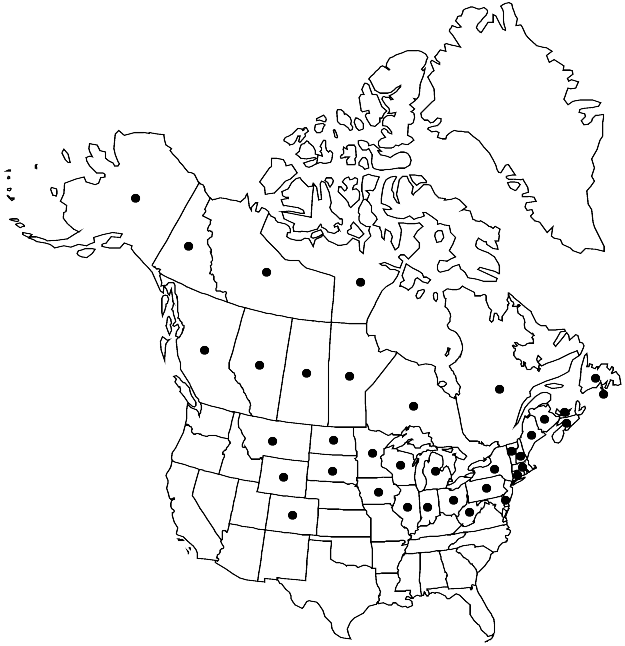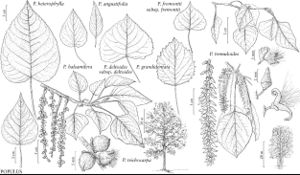Populus balsamifera
Sp. Pl. 2: 1034. 1753.
Plants to 40 m, 21 dm diam.; weakly heterophyllous. Bark reddish gray, furrowed. Branchlets reddish brown, becoming grayish brown by third year, round, 1.5–3.5(–5) mm diam., coarse, glabrous or glabrate to densely hairy. Winter buds reddish, glabrous, resinous (resin red, abundant, very fragrant, balsamic); terminal buds (8–)12–16(–20) mm; flowering buds clustered distally on branchlets, 15–19 mm. Leaves: petiole cylindrical or distally slightly flattened in plane of blade, (0.2–)1.5–5 cm, 1/3–1/2 blade length (usually glabrous); blade usually narrowly ovate to ovate, rarely broadly ovate, (2.5–)5–9(–15) × (0.7–)3–5.5(–9) cm, w/l = 1/2–2/3, base rounded to broadly cuneate or subcordate, basilaminar glands 0 or 2(–5), round, margins not translucent, not ciliate, apex obtuse to acute, abaxial surface often with reddish orange resin stains, glaucous, (veins prominent), adaxial dark green, glabrous; preformed blade margins subentire to very finely, evenly crenate-serrate throughout, teeth (9–)20–35(–45) on each side, sinuses 0.1–0.4 mm deep; neoformed blade margins finely crenate-serrate throughout, teeth (20–)30–45(–60) on each side, sinuses 0.2–0.6 mm deep. Catkins moderately loosely (35–)50–70(–80)-flowered, 7.5–15(–18 in fruit) cm; floral bract apex deeply cut, not ciliate. Pedicels 0.5–2(–3.5 in fruit) mm. Flowers: discs shallowly cup-shaped, not obviously oblique, entire, 2–3(–4) mm diam.; stamens 20–30; anthers truncate; ovary 2-carpelled, ovoid to spherical; stigmas 2–4, platelike, expanded, reflexed. Capsules ovoid, (3–)5–8 mm, glabrous, 2-valved. Seeds 15–22 per placenta. 2n = 38.
Phenology: Flowering Mar–Jun; fruiting May–Jul.
Habitat: Open, rich, low woods, cool, seasonally wet soils, bog margins in boreal forests, aspen parklands, montane streamsides, rocky slopes, gallery forests within tundra
Elevation: 0-2900 (-3700) m
Distribution

St. Pierre and Miquelon, Alta., B.C., Man., N.B., Nfld. and Labr. (Nfld.), N.W.T., N.S., Nunavut, Ont., P.E.I., Que., Sask., Yukon, Alaska, Colo., Conn., Del., Ill., Ind., Iowa, Maine, Mass., Mich., Minn., Mont., N.H., N.Y., N.Dak., Ohio, Pa., S.Dak., Vt., W.Va., Wis., Wyo.
Discussion
Populus balsamifera has been reported in error from Nebraska based on incorrectly localized specimens and from Idaho, Oregon, and Utah based on vegetative specimens of P. trichocarpa or intergrades. The two species can be difficult to separate vegetatively, particularly in their region of overlap and hybridization along the northern Cordilleran axis from southern Alaska to northwestern Wyoming. Their hybrids, named P. ×hastata Dode, have intermediate leaf shapes and also differ from P. balsamifera in having capsules with 2–4 sparsely hairy or glabrous valves (T. C. Brayshaw 1965). Populus balsamifera also hybridizes and intergrades with another native species of sect. Tacamahaca, P. angustifolia, to form P. ×brayshawii B. Boivin where the margins of their ranges overlap (Brayshaw 1965b). Populus ×brayshawii is intermediate in some respects between its parents. It is most similar to P. angustifolia; it differs in longer petioles and darker twigs, characteristics in which it approaches P. balsamifera. Some trees of P. balsamifera from North Dakota (Bottineau and Divide counties) also seem to show an influence of P. angustifolia, although they are far from the present range of the latter species.
Populus ×jackii Sargent (synonyms P. ×andrewsii Sargent, P. ×bernardii B. Boivin, P. ×dutillyi Lepage, and P. ×gileadensis Rouleau) is an intersectional hybrid with P. deltoides (sect. Aigeiros) and is moderately common in riparian and other wet habitats throughout the broad range of overlap between these two species (Alberta, Colorado, Illinois, Indiana, Iowa, Manitoba, Massachusetts, Michigan, Minnesota, Montana, Nebraska, New York, North Dakota, Ontario, Quebec, Pennsylvania, Saskatchewan, South Dakota, West Virginia, and Wisconsin) (W. G. Ronald et al. 1973; J. E. Eckenwalder 1984). A pistillate clone that probably arose from this hybrid by segregation or backcrossing (‘Balm-of-Gilead’) has been widely cultivated since at least the eighteenth century for its bud resin, used in treating coughs (E. Rouleau 1948). Capsules rarely, if ever, mature and trees do not appear to produce fertile seed, but persist and spread by root sprouts in waste places and at edges of woods. It is cultivated mostly in southeastern Canada and eastern United States to the Great Plains, chiefly in mountains in southeastern United States. This clone is more balsam poplarlike than first generation hybrids and has differences from wild hybrids in North America. It may have arisen in Europe through hybridization and backcrossing between P. balsamifera and southern P. deltoides subsp. deltoides. Most wild hybrids have P. deltoides subsp. monilifera as the cottonwood parent.
Similar to the other North American balsam poplars, Populus balsamifera hybridizes sporadically with the introduced Eurasian P. nigra. That hybrid, P. ×rollandii Rouleau, which was originally thought to have involved P. ×canadensis, itself a hybrid offspring of P. nigra, has been collected in the vicinity of Montreal, Quebec (E. Rouleau 1944). Its leaves are similar in shape to those of P. ×canadensis but have the reddish resin stains and cylindrical petioles of P. balsamifera.
Populus balsamifera does not hybridize naturally with P. tremuloides, as sometimes reported (E. Lepage 1961; F. G. Bernard 1968). Specimens that formed the basis for those reports are either P. ×jackii or slender sucker shoots of P. tremuloides bearing correspondingly narrow leaves.
Populus ×jackii has branchlets that are short-haired or pubescent, petioles densely pubescent, at least distally, preformed blade margins with 20(–45) teeth on each side, sinuses to 1.5 mm deep, pedicels to 3 mm, discs saucer-shaped, 1–4 mm diam., ovaries 3- or 4-carpelled and glabrous, capsules usually 3- or 4-valved, ovoid, (4–)8–11(–16) mm, and seeds (6 or) 7–15(–25) per placenta. It is similar to P. simonii in having winter buds with red resin, petioles to 2 cm, round, cylindrical, or distally slightly flattened in the plane of blade, leaf blades lighter green abaxially, elliptic-rhombate to ovate, (1–)3–20(–27.5) cm, bases acute, cuneate, rounded, truncate, or shallowly cordate, apices obtuse, acute, or acuminate, and surfaces not obviously resin-stained, with abaxial surface glabrous or with short, stiff hairs. The flowers are similar with discs entire, persistent, and not obviously oblique, catkins with floral bracts not ciliate and glabrous abaxially, 10–60(–70) stamens (P. simonii with fewer than 12), anthers usually truncate, stigmas 2–4 and expanded, and ovaries ovoid to spherical. In addition to these traits, P. simonii has terminal buds that are usually less than 12 mm, branchlets whitish tan by the third year, catkins 3–8 cm, and stamens usually fewer than 12.
Selected References
None.
